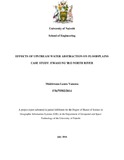| dc.contributor.author | Mukhwana, Laura, V | |
| dc.date.accessioned | 2017-01-11T04:57:33Z | |
| dc.date.available | 2017-01-11T04:57:33Z | |
| dc.date.issued | 2016 | |
| dc.identifier.uri | http://hdl.handle.net/11295/100238 | |
| dc.description.abstract | Ewaso Ng’iro North River basin is experiencing multiple stressors from water over-abstraction and over-exploitation, land use change and agricultural intensification. Agricultural intensification in upper basin is heavily reliant on water abstraction from river with detrimental impacts particularly reduced dry season flows into downstream areas. This study assesses the impacts of upstream water abstraction on the flooding extent in the downstream floodplains of the Ewaso Ng’iro North River. The methodology used to meet the objectives was reclassification of the Normalized Difference Vegetation Index (NDVI) generated maps to assess and identify the changes in the vegetation cover, NDVI differencing to determine the changed areas along with supervised classification for mapping the spatial extent of mesquite trees specifically, Prosopis juliflora (Sw)Dc. The efficient mapping of resulting changes in the floodplains is essential for monitoring the impacts of human activities like water abstraction and it gives crucial information for water resources planning and management. The results indicate that reduced flow has contributed to the reduction is some vegetation cover classes specifically the moderate and dense vegetation. Moderate vegetation has the greatest decline by 58% followed by dense vegetation by 51% from 2002 to 2015. The sparse vegetation on the other hand, increased by 3%. Results indicate that the area lost by the moderate and dense vegetation has been replaced by sparse vegetation, The NDVI image analyses also indicate that the vegetation biomass and health decreased over the period. There is also an increase in the vegetation NDVI reflectances of some vegetation covering 1% while 16% of the reflectances decreased. 83% of the area remained unchanged. Prosopis juliflora is also spreading in the floodplains and covers an estimated 19 671ha. This is evidence that the hydrology of the floodplain is changing. More research needs to be done on the impacts of climate change on the floodplains as well as morphological changes that have occurred due to reduced flow. The local authorities also need to find mechanisms for controlling the spread of Prosopis juliflora. In addition, the spread of Prosopis should be examined through analysis of more images from previous years so as to monitor its spread and estimate the rate of its invasion. | en_US |
| dc.language.iso | en | en_US |
| dc.publisher | University of Nairobi | en_US |
| dc.rights | Attribution-NonCommercial-NoDerivs 3.0 United States | * |
| dc.rights.uri | http://creativecommons.org/licenses/by-nc-nd/3.0/us/ | * |
| dc.subject | Effects of Upstream Water Abstraction on Floodplains | en_US |
| dc.title | Effects of Upstream Water Abstraction on Floodplains Case Study: Ewaso Ng’iro North River | en_US |
| dc.type | Thesis | en_US |



